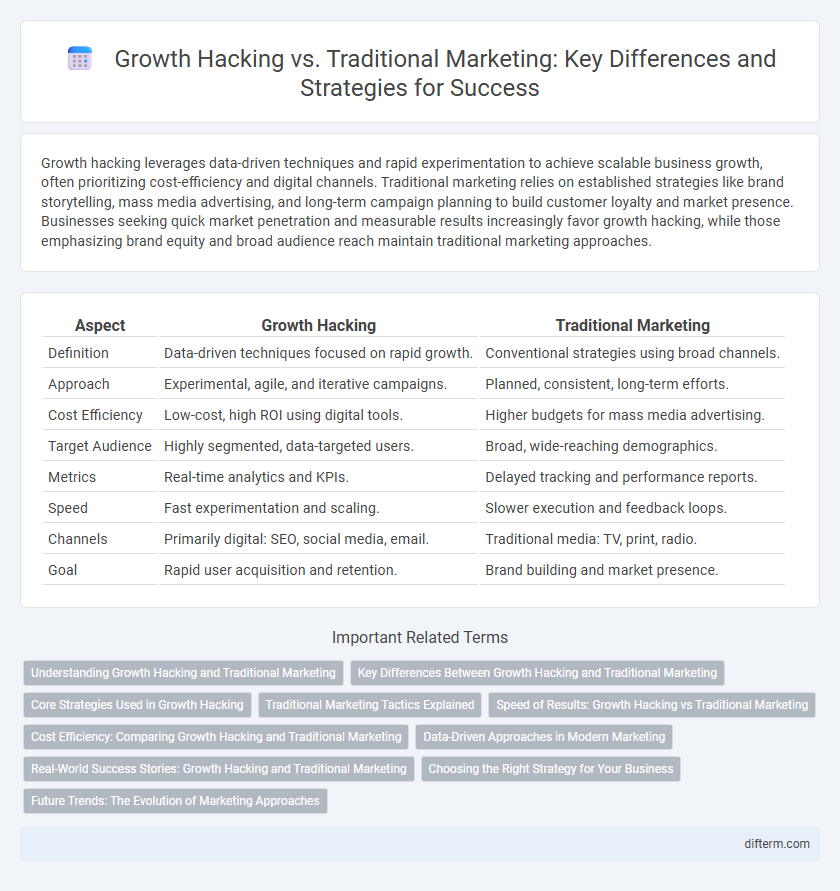Growth hacking leverages data-driven techniques and rapid experimentation to achieve scalable business growth, often prioritizing cost-efficiency and digital channels. Traditional marketing relies on established strategies like brand storytelling, mass media advertising, and long-term campaign planning to build customer loyalty and market presence. Businesses seeking quick market penetration and measurable results increasingly favor growth hacking, while those emphasizing brand equity and broad audience reach maintain traditional marketing approaches.
Table of Comparison
| Aspect | Growth Hacking | Traditional Marketing |
|---|---|---|
| Definition | Data-driven techniques focused on rapid growth. | Conventional strategies using broad channels. |
| Approach | Experimental, agile, and iterative campaigns. | Planned, consistent, long-term efforts. |
| Cost Efficiency | Low-cost, high ROI using digital tools. | Higher budgets for mass media advertising. |
| Target Audience | Highly segmented, data-targeted users. | Broad, wide-reaching demographics. |
| Metrics | Real-time analytics and KPIs. | Delayed tracking and performance reports. |
| Speed | Fast experimentation and scaling. | Slower execution and feedback loops. |
| Channels | Primarily digital: SEO, social media, email. | Traditional media: TV, print, radio. |
| Goal | Rapid user acquisition and retention. | Brand building and market presence. |
Understanding Growth Hacking and Traditional Marketing
Growth hacking leverages data-driven experimentation, rapid testing, and innovative digital tactics to accelerate user acquisition and optimize marketing efficiency. Traditional marketing relies on established channels such as print, television, and direct mail, focusing on brand awareness and long-term relationship building. Understanding growth hacking involves recognizing its emphasis on scalability and agility, while traditional marketing prioritizes consistent messaging and broad audience reach.
Key Differences Between Growth Hacking and Traditional Marketing
Growth hacking emphasizes rapid experimentation across marketing channels and product development to identify the most efficient ways to grow a business, leveraging data-driven tactics and automation tools. Traditional marketing relies on long-term strategies, brand positioning, and broad audience targeting through established channels like TV, print, and radio. The key differences lie in growth hacking's focus on agility, measurable metrics, and scalable growth versus traditional marketing's emphasis on brand consistency, market research, and customer loyalty.
Core Strategies Used in Growth Hacking
Growth hacking leverages data-driven experimentation, rapid testing, and viral marketing techniques to accelerate user acquisition and retention, contrasting with traditional marketing's reliance on broad messaging and brand awareness campaigns. Core strategies include leveraging analytics for continuous optimization, utilizing social media platforms for organic growth, and employing product-market fit tactics to enhance customer engagement. This approach prioritizes scalable and cost-effective methods, emphasizing agility and innovation to drive exponential growth.
Traditional Marketing Tactics Explained
Traditional marketing tactics encompass strategies such as print advertising, direct mail, television and radio commercials, and event sponsorships, leveraging established media channels to reach a broad audience. These methods often rely on demographic targeting and brand positioning through consistent messaging across physical and broadcast platforms. Despite the rise of digital alternatives, traditional marketing remains effective for building local brand awareness and driving offline customer engagement.
Speed of Results: Growth Hacking vs Traditional Marketing
Growth hacking delivers rapid results by leveraging data-driven experiments and agile strategies that enable marketers to quickly identify and scale successful tactics. Traditional marketing often involves longer campaign cycles with extensive planning and slower feedback loops, delaying measurable outcomes. The speed advantage of growth hacking accelerates customer acquisition and ROI compared to the slower, more methodical pace of traditional marketing methods.
Cost Efficiency: Comparing Growth Hacking and Traditional Marketing
Growth hacking leverages data-driven strategies and low-cost digital tools to maximize ROI, often delivering higher cost efficiency than traditional marketing methods reliant on large budgets for mass media advertising. Traditional marketing requires significant investments in TV, print, and outdoor campaigns, which can lead to higher fixed costs and less precise targeting. By focusing on rapid experimentation and viral growth tactics, growth hacking minimizes spending while achieving scalable results and measurable success.
Data-Driven Approaches in Modern Marketing
Growth hacking leverages real-time analytics and user behavior data to rapidly test and optimize marketing strategies, enabling faster scalability compared to traditional marketing's reliance on historical data and broad demographic targeting. Data-driven approaches in modern marketing emphasize continuous experimentation, personalization, and automation through tools like AI and machine learning to enhance customer acquisition and retention. Traditional marketing often focuses on fixed campaigns and brand awareness, while growth hacking prioritizes agile, measurable results directly linked to key performance indicators (KPIs).
Real-World Success Stories: Growth Hacking and Traditional Marketing
Airbnb's growth hacking strategy leveraged user-generated content and viral referral programs, rapidly expanding its user base without heavy traditional advertising spend. Coca-Cola's traditional marketing campaigns use consistent brand messaging and mass media to maintain global market dominance and customer loyalty. Both approaches show measurable success: growth hacking excels in fast, cost-effective scaling while traditional marketing secures long-term brand equity.
Choosing the Right Strategy for Your Business
Growth hacking leverages data-driven experiments and rapid iteration to optimize customer acquisition and retention, making it ideal for startups and businesses with limited budgets seeking fast growth. Traditional marketing relies on established channels like print, TV, and radio to build long-term brand awareness and trust, suitable for companies with larger budgets and a focus on sustained market presence. Selecting the right strategy depends on your business goals, budget constraints, and the need for speed versus brand equity development.
Future Trends: The Evolution of Marketing Approaches
Growth hacking leverages data-driven experimentation, automation, and AI to rapidly scale customer acquisition, outperforming traditional marketing's reliance on broad campaigns and fixed budgets. Future marketing trends indicate a shift towards personalized, real-time engagement powered by machine learning, predictive analytics, and seamless integration across digital channels. Businesses adopting growth hacking techniques will stay ahead by continuously optimizing tactics based on performance metrics, while traditional marketing may struggle to adapt to fast-evolving consumer behaviors.
Growth Hacking vs Traditional Marketing Infographic

 difterm.com
difterm.com